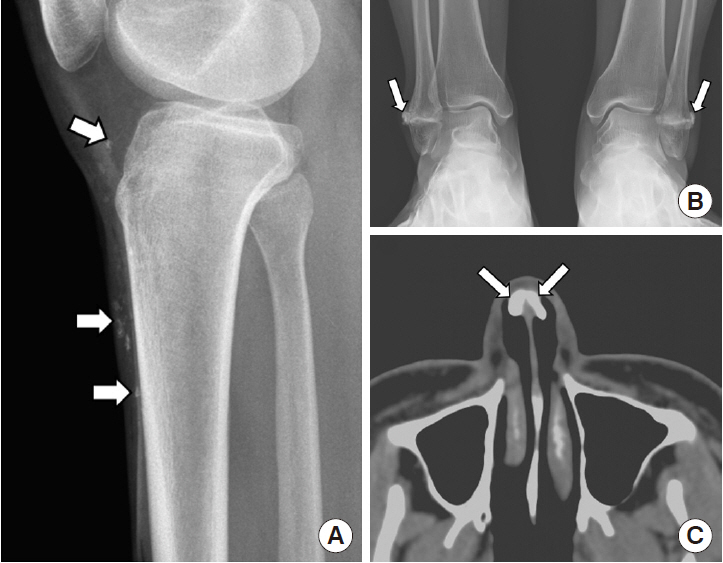Lab Med Online.
2020 Apr;10(2):175-178. 10.3343/lmo.2020.10.2.175.
The First Korean Case of Gorlin?Goltz Syndrome Caused by a PTCH2 Pathogenic Variant Identified via Whole Exome Sequencing
- Affiliations
-
- 1Department of Laboratory Medicine and Genetics, Samsung Medical Center, Sungkyunkwan University School of Medicine, Seoul, Korea
- 2Department of Radiology and Center for Imaging Science, Samsung Medical Center, Sungkyunkwan University School of Medicine, Seoul, Korea
- KMID: 2512250
- DOI: http://doi.org/10.3343/lmo.2020.10.2.175
Abstract
- Gorlin–Goltz syndrome, also known as basal cell nevus syndrome, is a condition that affects several body parts and increases the risk of developing various cancerous and noncancerous tumors. This syndrome is mostly caused by the pathogenic variants of the PTCH1 and SUFU genes; however, it is rarely diagnosed due to limited prevalence. PTCH2 has rarely been identified as a pathogenic variant in patients with the Gorlin–Goltz syndrome in China and Japan. Here, we report the case of a 30-year-old woman who was diagnosed with the Gorlin–Goltz syndrome—based on multiple calcifications on the body—who carried a frame shift pathogenic variant of the PTCH2 gene (c.1172_1173del) identified via whole exome sequencing. The patient did not present the typical phenotypes of the Gorlin–Goltz syndrome, such as basal cell carcinoma, palmar/plantar pits, macrocephaly, and keratocystic odontogenic tumors. Based on these observations, we suggest that a pathogenic variant of PTCH2 can manifest a milder phenotype of the Gorlin–Goltz syndrome.
Keyword
Figure
Reference
-
1. Hasegawa D, Ochiai-Shino H, Onodera S, Nakamura T, Saito A, Onda T, et al. 2017; Gorlin syndrome-derived induced pluripotent stem cells are hypersensitive to hedgehog-mediated osteogenic induction. PLoS One. 12:e0186879. DOI: 10.1371/journal.pone.0186879. PMID: 29088246. PMCID: PMC5663396.
Article2. Johnson RL, Rothman AL, Xie J, Goodrich LV, Bare JW, Bonifas JM, et al. 1996; Human homolog of patched, a candidate gene for the basal cell nevus syndrome. Science. 272:1668–71. DOI: 10.1126/science.272.5268.1668. PMID: 8658145.
Article3. Fujii K, Kohno Y, Sugita K, Nakamura M, Moroi Y, Urabe K, et al. 2003; Mutations in the human homologue of Drosophila patched in Japanese nevoid basal cell carcinoma syndrome patients. Hum Mutat. 21:451–2. DOI: 10.1002/humu.9132. PMID: 12655573.4. Fujii K, Ohashi H, Suzuki M, Hatsuse H, Shiohama T, Uchikawa H, et al. 2013; Frameshift mutation in the PTCH2 gene can cause nevoid basal cell carcinoma syndrome. Fam Cancer. 12:611–4. DOI: 10.1007/s10689-013-9623-1. PMID: 23479190.5. Fan Z, Li J, Du J, Zhang H, Shen Y, Wang CY, et al. 2008; A missense mutation in PTCH2 underlies dominantly inherited NBCCS in a Chinese family. J Med Genet. 45:303–8. DOI: 10.1136/jmg.2007.055343. PMID: 18285427.6. Evans DG, Farndon PA, Burnell LD, Gattamaneni HR, Birch JM. 1991; The incidence of Gorlin syndrome in 173 consecutive cases of medulloblastoma. Br J Cancer. 64:959–61. DOI: 10.1038/bjc.1991.435. PMID: 1931625. PMCID: PMC1977448.
Article7. Richards S, Aziz N, Bale S, Bick D, Das S, Gastier-Foster J, et al. 2015; Standards and guidelines for the interpretation of sequence variants: a joint consensus recommendation of the American College of Medical Genetics and Genomics and the Association for Molecular Pathology. Genet Med. 17:405–24. DOI: 10.1038/gim.2015.30. PMID: 25741868. PMCID: PMC4544753.
Article8. Wicking C, Shanley S, Smyth I, Gillies S, Negus K, Graham S, et al. 1997; Most germ-line mutations in the nevoid basal cell carcinoma syndrome lead to a premature termination of the PATCHED protein, and no genotypephenotype correlations are evident. Am J Hum Genet. 60:21–6.9. Brugieres L, Pierron G, Chompret A, Paillerets BB, Di Rocco F, Varlet P, et al. 2010; Incomplete penetrance of the predisposition to medulloblastoma associated with germ-line SUFU mutations. J Med Genet. 47:142–4. DOI: 10.1136/jmg.2009.067751. PMID: 19833601.
Article10. Nagao K, Fujii K, Saito K, Sugita K, Endo M, Motojima T, et al. 2011; Entire PTCH1 deletion is a common event in point mutation-negative cases with nevoid basal cell carcinoma syndrome in Japan. Clin Genet. 79:196–8. DOI: 10.1111/j.1399-0004.2010.01527.x. PMID: 21210781.
Article11. Ono M, Nishijima S, Amagata T, Ikeda T, Yakubo K, Akatsuka S, et al. 2015; Two consecutive births after ovarian preservation in a Gorlin syndrome patient. J Obstet Gynaecol. 35:96–7. DOI: 10.3109/01443615.2014.937682. PMID: 25026324.
Article
- Full Text Links
- Actions
-
Cited
- CITED
-
- Close
- Share
- Similar articles
-
- Whole-exome sequencing analysis in a case of primary congenital glaucoma due to the partial uniparental isodisomy
- A Familial Case with Phenotypic Differences in a CAV3 Pathogenic Variant
- Radiological features of familial Gorlin-Goltz syndrome
- Novel Pathogenic Variant (c.3178G>A) in the SMC1A Gene in a Family With Cornelia de Lange Syndrome Identified by Exome Sequencing
- Imaging findings in a case of Gorlin-Goltz syndrome: a survey using advanced modalities


